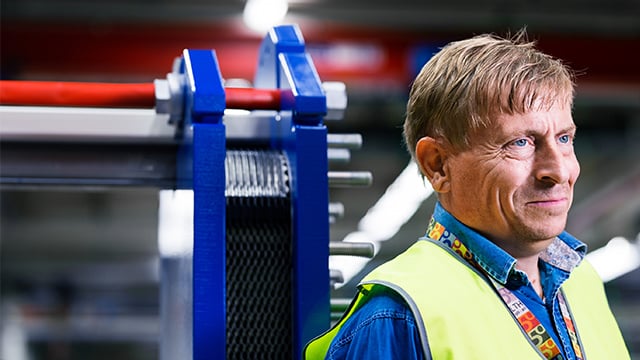Plate Heat Exchanger Calculation Method
As heat transfer experts with decades of experience, Alfa Laval provides unparalleled insight into plate heat exchanger calculation methods. This page offers a professional guide to heat exchanger sizing, detailing the crucial equations and parameters needed to solve thermal problems accurately. Trust in our expertise to help you understand the science behind efficient thermal solutions.
To solve a thermal problem, we need to know several parameters. Further data can then be determined.
The six most important parameters include:
- The amount of heat to be transferred (heat load)
- The inlet and outlet temperatures on the primary and secondary sides
- The maximum allowable pressure drop on the primary and secondary sides
- The maximum operating temperature
- The maximum operating pressure
- The flowrate on the primary and secondary sides
If the flow rate, specific heat and temperature difference on one side are known, the heat load can be calculated.
How do you calculate the heat transfer area of a plate heat exchanger?
The heat load of a heat exchanger can be derived from the following two formulas:
1. Heat load, Theta and LMTD calculation
Where:
P = heat load (btu/h)
m = mass flow rate (lb/h)
cp = specific heat (btu/lb °F)
δt = temperature difference between inlet and outlet on one side (°F)
k = heat transfer coefficient (btu/ft2 h °F)
A = heat transfer area (ft2)
LMTD = log mean temperature difference
T1 = Inlet temperature - hot side
T2 = Outlet temperature - hot side
T3 = Inlet temperature - cold side
T4 = Outlet temperature - cold side
LMTD can be calculated by using the following formula, where ∆T1 = T1–T4 and ∆T2 = T2–T3
2. Heat transfer coefficient and design margin
The total overall heat transfer coefficient k is defined as:
α1 = The heat transfer coefficient between the warm medium and the heat transfer surface (btu/ft2 h °F)
α2 = The heat transfer coefficient between the heat transfer surface and the cold medium (btu/ft2 h °F)
δ = The thickness of the heat transfer surface (ft)
Rf = The fouling factor (ft2 h °F/btu)
λ = The thermal conductivity of the material separating the medias (btu/ft2 h °F)
kc = Clean heat transfer coefficient (Rf=0) (btu/ft2 h °F)
k = Design heat transfer coefficient (btu/ft2 h °F)
M = Design Margin (%)
Combination of these two formulas gives: M = kc · Rf
i.e the higher kc value, the lower Rf-value to achieve the same design margin.
For a more complete explanation of heat transfer theory and calculations, download the following brochure:
The theory behind heat transfer
Chat with our heat transfer experts
Struggling to solve your thermal problem? Need help with sizing a heat exchanger?
Please fill out the below form, and one of our heat transfer experts will be in touch shortly.
The theory behind heat transfer
Download our free document and learn about the theory behind heat transfer:
Glossary of Heat Exchanger Calculation Terms
Heat Load: The amount of heat energy that needs to be transferred per unit of time. This is a critical starting point for any heat exchanger calculation.
Log Mean Temperature Difference (LMTD): A logarithmic average of the temperature difference between the hot and cold fluids. It represents the effective temperature driving force for heat transfer in the heat exchanger.
Overall Heat Transfer Coefficient (k): A measure of the total thermal resistance to heat flow. It's influenced by the properties of the two fluids, the plate material, and the fouling factor.
Pressure Drop: The decrease in fluid pressure as it moves through the heat exchanger. It's a key design constraint, as excessive pressure drop can lead to higher pumping costs.
Fouling Factor: A measure of the resistance to heat transfer caused by the build-up of deposits (e.g., scale or sediment) on the heat exchanger surfaces. A higher fouling factor indicates more resistance.
Heat Transfer Surface: The total area of the plates where heat is exchanged between the hot and cold fluids. This surface area () is a key factor in the overall heat transfer equation.
Mass Flow Rate: The mass of a fluid moving past a point per unit of time (). This is a primary input for calculating the heat load and is essential for sizing the heat exchanger.
Specific Heat: The amount of thermal energy required to change the temperature of a unit mass of a substance by one degree (). This value is crucial for determining the heat load ().
Temperature Cross: A highly efficient condition where the outlet temperature of the cold fluid is higher than the outlet temperature of the hot fluid. This can be achieved with counter-current flow and is relevant to LMTD calculations.
Thermal Conductivity: A material property that measures its ability to conduct heat. The thermal conductivity of the plate material () is a factor in the overall heat transfer coefficient.
Our Comprehensive Heat Exchanger Portfolio
At Alfa Laval, we understand that every process is unique. That's why we offer the market's most comprehensive and diverse portfolio of heat exchangers, meticulously engineered to meet the specific demands of any industry or application. From compact and efficient brazed units to flexible and serviceable gasketed designs, our range ensures optimal performance, energy savings, and reliability. Explore our solutions to find the perfect heat transfer technology for your needs.


